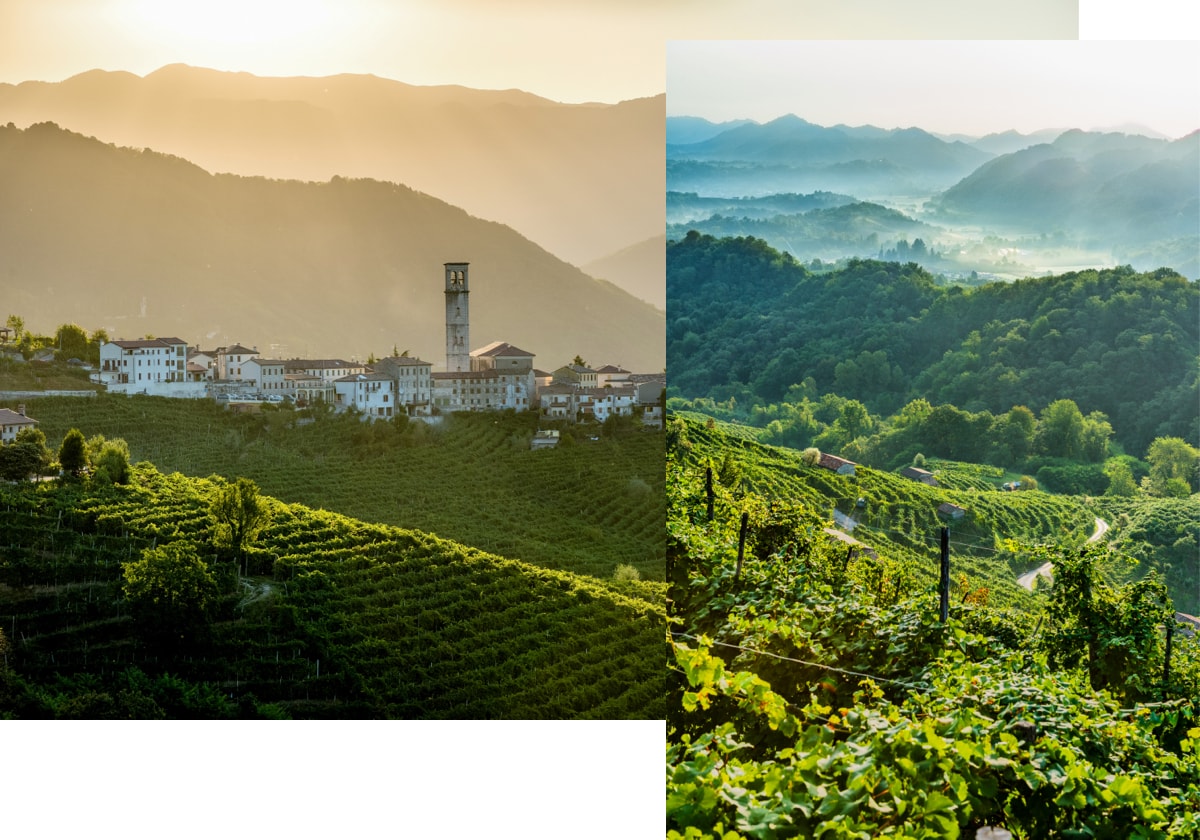Universal Values
After a procedure that began in 2008, the site “Le Colline del Prosecco di Conegliano e Valdobbiadene” was enrolled on the World Heritage List as a cultural landscape in 2019, where the work of winegrowers has contributed to creating a unique scenery.
The Prosecco Hills of Conegliano and Valdobbiadene, in northeastern Italy, are characterised by a distinctive morphological ridge system that offers a mountainous character with panoramic views and an evolved and continuous organic landscape composed of vineyards, forests, small villages and agriculture. For centuries, the rough terrain has been shaped and adapted by distinctive land use practices. This includes soil and land use conservation techniques, which involve viticultural practices that use Glera grapes to produce the highest quality Prosecco wine. Since the 17th century, the use of ciglioni – the grassy terraces used to cultivate areas with steep slopes – has created a distinctive checkerboard pattern with rows parallel and vertical to the slopes.
In the 19th century, specific vine breeding, known as “bellussera”, was developed by local farmers, helping to shape the aesthetic characteristic of the landscape.
The mosaic appearance of the landscape is the result of historical and ongoing environmental and land use practices. Plots devoted to vineyards, established on the ridges, coexist with wooded patches, small forests, hedges and rows of trees that serve as corridors linking different habitats. Small villages are scattered in the ridges, along narrow valleys or on ridges.
Criterion (V)*
The Prosecco Hills of Conegliano and Valdobbiadene are a viticultural landscape resulting from the interaction of nature and people over several centuries. The adaptation and transformation of the challenging soil of the geomorphology of the ridges has required the development of specific land use practices, including: hand vineyards management on steep slopes; the grassy terraces known as ciglioni, which follow the contours of the landscape, stabilising the soils and vines; and the bellussera farming system that was developed in the area around 1880. As a result, the vineyards help shape a distinctive “checkerboard” appearance, with perpendicular rows of tall vines interspersed with rural settlements, forests and small woods. Despite many changes, the history of sharecropping in this area is also reflected on the landscape.
Integrity
The site border is appropriately sized and contains the characteristics of the Outstanding Universal Value within a distinct and intact topography. Despite many changes and the challenges caused by plague, wars, poverty, and the industrialization of viticulture, many of the features (such as vineyards, verges and architectural elements) show a good state of preservation, and areas of forest have been maintained. Ecological processes are of paramount importance for the sustainability of the landscape and vineyards. Threats are currently managed, although the conservation status of some elements (particularly architectural and urban elements in the buffer zone) require some improvement. In addition to that, climate change has accentuated the incidence of landslides. The landscape may be susceptible to irreversible changes due to the pressures of Prosecco production within a growing global market. Agricultural and viticultural techniques to maintain the integrity of the landscape, including hand-harvesting continue.
Authenticity
The main features of the site relate to the distinctive landscape where nature and human history shaped and were shaped by an adapted and specific system to viticulture and land use. Despite many changes, the features show authenticity and are documented through sources such as inventories and land registries, historical and religious paintings, historical documents showing the introduction of ciglioni, and the operation of the sharecropping system from the earliest land registry in the 18th century.

Management and protection requirements
The site and its features are subject to national and local protection measures. In fact, municipalities and professional associations have introduced additional protections through land use planning tools and through the formulation of voluntary and legal documents. The protection of the rural landscape is ensured first and foremost by the rules of the Conegliano Valdobbiadene Prosecco Superiore DOCG consortium, which encourage the maintenance of vineyards, verges and other features that are fundamental in order to maintain local traditions and protecting agricultural biodiversity and associated ecosystem services. Almost the entire site has been nominated to the National Register of Historical Rural Landscapes, a program developed by the Ministry of Agriculture to protect rural agricultural landscapes.
Forest vegetation is protected by the restrictions forming part of the National Code of Cultural Heritage, as well as by the management plan of the Site of Community Interest (SCI) of the EU Natura 2000 network. Buildings of historical and monumental value are protected at a national level by the Code for Cultural Heritage and Landscape, enacted by Legislative Decree No. 42 of January 22, 2004, along with all public, state-owned buildings as well as those owned by the Catholic Church that are more than 50 years old. Legal protection could be further strengthened through the implementation of the Detailed Landscape Plan at a regional level; the implementation of the Intermunicipal regulation of rural police; and the full implementation of the “technical rule – single article” in all relevant municipalities. Site management is mainly linked to plans and planning processes developed by local authorities – Veneto Region and Province of Treviso – which support and ensure the participation of all stakeholders through a specific regional law (No. 45/2017). The construction of new production areas and buildings in the agricultural zone that are not strictly necessary for the cultivation of farmland is not allowed. The management plan requires further development, adoption and implementation.
● The proposed motive for Outstanding Universal Value as a cultural landscape included Criterion (V), that is: “To be an outstanding example of a traditional human settlement, land use or sea use that is representative of a culture (or cultures) or human interaction with the environment, especially when it has become vulnerable to the impact of irreversible changes”.